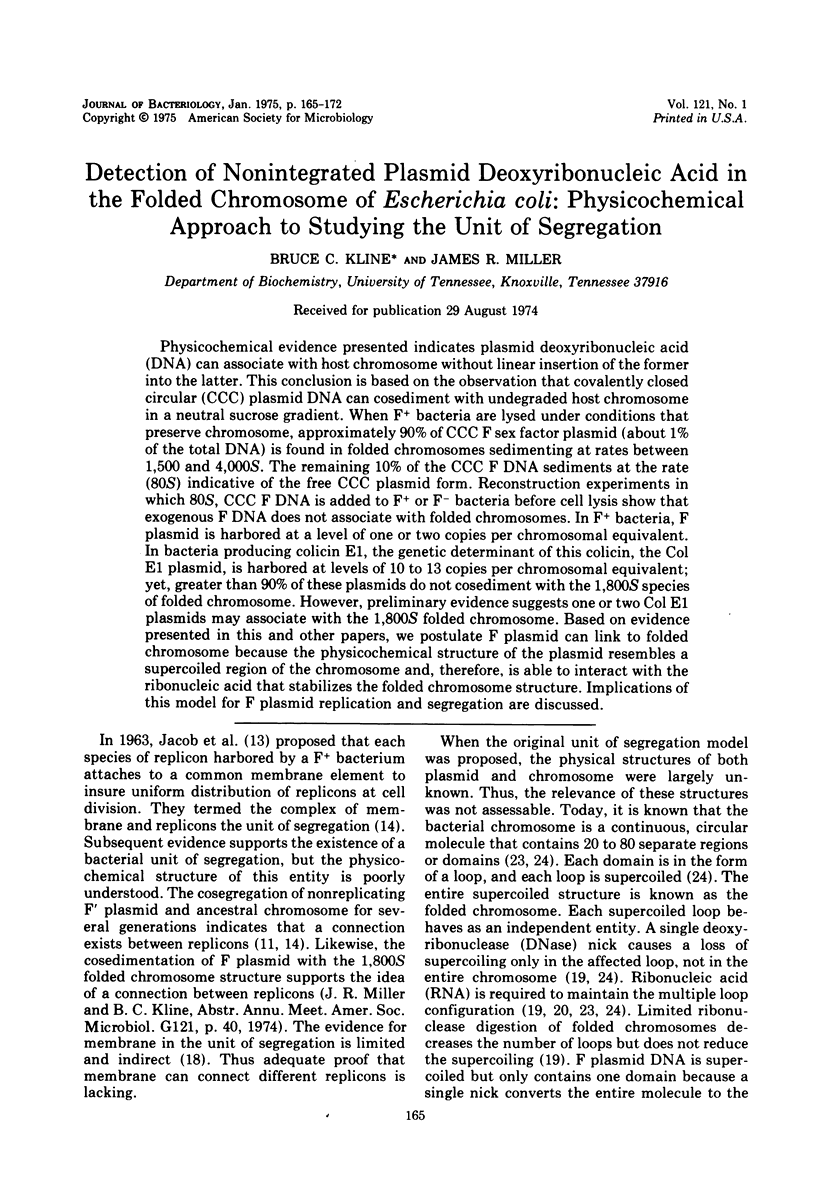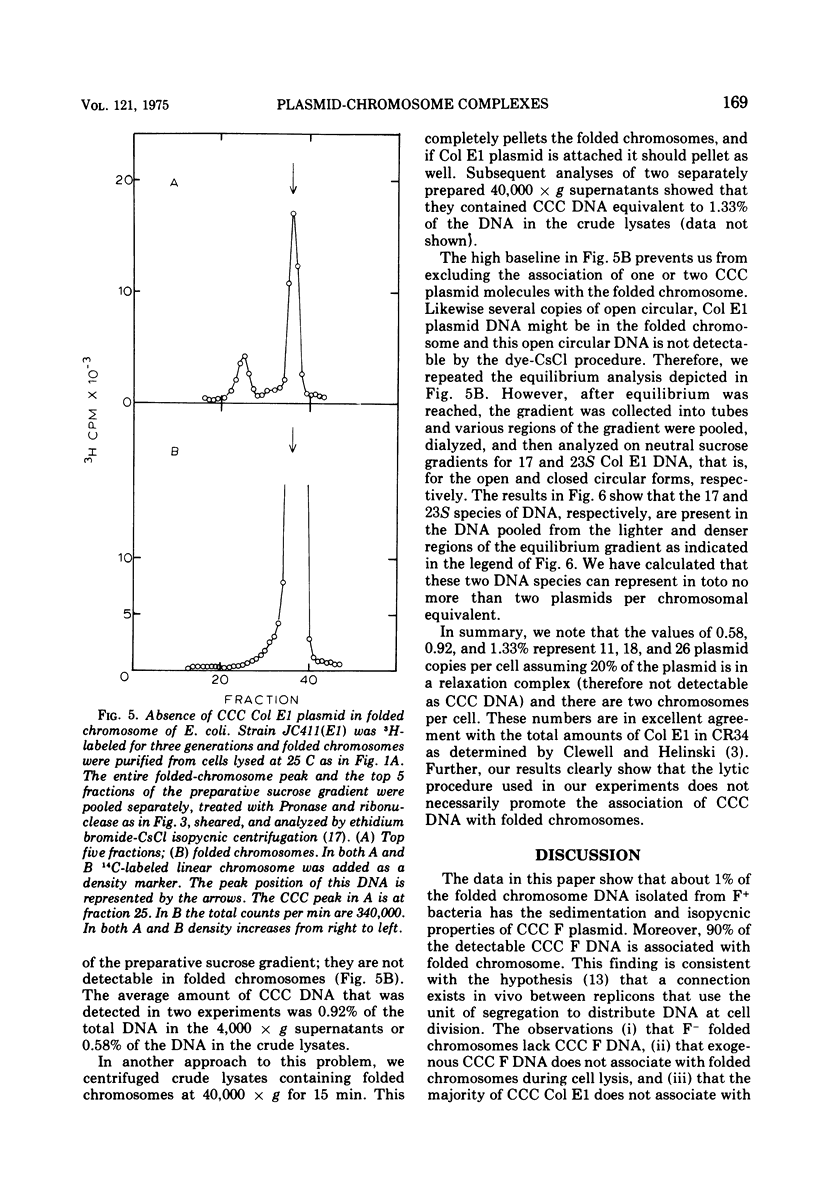Abstract
Physiocochemical evidence presented indicates plasmid deoxyribonucleic acid (DNA) can associate with host chromosome without linear insertion of the former into the latter. This conclusion is based on the observation that covalently closed circular (CCC) plasmid DNA can cosediment with undegraded host chromosome in a neutral sucrose gradient. When F plus bacteria are lysed under conditions that preserve chromosome, approximately 90% of CCC F sex factor plasmid (about 1% of the total DNA) is found in folded chromosomes sedimenting at rates between 1,500 and 4,000s. The remaining 10% of the CCC F DNA sediments at the rate (80S) indicative of the free CCC plasmid form. Reconstruction experiments in which 80S, CCC F DNA is added to F plus or F minus bacteria before cell lysis show that exogenous F DNA does not associate with folded chromosomes. In F plus bacteria, F plasmid is harbored at a level of one or two copies per chromosomal equivalent. In bacteria producing colicin E1, the genetic determinant of this colicin, the Col E1 plasmid, is harbored at levels of 10 to 13 copies per chromosomal equivalent; yet, greater than 90% of these plasmids do not cosediment with the 1,800S species of folded chromosome. However, preliminary evidence suggests one or two Col E1 plasmids may associate with the 1,800S folded chromosome. Based on evidence presented in this and other papers, we postulate F plasmid can link to folded chromosome because the physicochemical structure of the plasmid resembles a supercoiled region of the chromosome and, therefore, is able to interact with the ribonucleic acid that stabilizes the folded chromosome structure. Implications of this model for F plasmid replication and segregation are discussed.
Full text
PDF







Selected References
These references are in PubMed. This may not be the complete list of references from this article.
- Bazaral M., Helinski D. R. Replication of a bacterial plasmid and an episome in Escherichia coli. Biochemistry. 1970 Jan 20;9(2):399–406. doi: 10.1021/bi00804a029. [DOI] [PubMed] [Google Scholar]
- Clewell D. B., Helinski D. R. Effect of growth conditions on the formation of the relaxation complex of supercoiled ColE1 deoxyribonucleic acid and protein in Escherichia coli. J Bacteriol. 1972 Jun;110(3):1135–1146. doi: 10.1128/jb.110.3.1135-1146.1972. [DOI] [PMC free article] [PubMed] [Google Scholar]
- Clewell D. B., Helinski D. R. Supercoiled circular DNA-protein complex in Escherichia coli: purification and induced conversion to an opern circular DNA form. Proc Natl Acad Sci U S A. 1969 Apr;62(4):1159–1166. doi: 10.1073/pnas.62.4.1159. [DOI] [PMC free article] [PubMed] [Google Scholar]
- Clowes R. C. Molecular structure of bacterial plasmids. Bacteriol Rev. 1972 Sep;36(3):361–405. doi: 10.1128/br.36.3.361-405.1972. [DOI] [PMC free article] [PubMed] [Google Scholar]
- Collins J., Pritchard R. H. Relationship between chromosome replication and F'lac episome replication in Escherichia coli. J Mol Biol. 1973 Jun 25;78(1):143–155. doi: 10.1016/0022-2836(73)90434-8. [DOI] [PubMed] [Google Scholar]
- Cooper S. Relationship of Flac replication and chromosome replication. Proc Natl Acad Sci U S A. 1972 Sep;69(9):2706–2710. doi: 10.1073/pnas.69.9.2706. [DOI] [PMC free article] [PubMed] [Google Scholar]
- Davis D. B., Helmstetter C. E. Control of F'lac replication in Escherichia coli B-r. J Bacteriol. 1973 Apr;114(1):294–299. doi: 10.1128/jb.114.1.294-299.1973. [DOI] [PMC free article] [PubMed] [Google Scholar]
- Delius H., Worcel A. Letter: Electron microscopic visualization of the folded chromosome of Escherichia coli. J Mol Biol. 1974 Jan 5;82(1):107–109. doi: 10.1016/0022-2836(74)90577-4. [DOI] [PubMed] [Google Scholar]
- Dworsky P., Schaechter M. Effect of rifampin on the structure and membrane attachment of the nucleoid of Escherichia coli. J Bacteriol. 1973 Dec;116(3):1364–1374. doi: 10.1128/jb.116.3.1364-1374.1973. [DOI] [PMC free article] [PubMed] [Google Scholar]
- Goebel W. The influence of DNA A and DNA C mutations on the initiation of plasmid DNA replication. Biochem Biophys Res Commun. 1973 Apr 16;51(4):1000–1007. doi: 10.1016/0006-291x(73)90026-0. [DOI] [PubMed] [Google Scholar]
- Hohn B., Korn D. Cosegregation of a sex factor with the Escherichia coli chromosome during curing by acridine orange. J Mol Biol. 1969 Oct 28;45(2):385–395. doi: 10.1016/0022-2836(69)90113-2. [DOI] [PubMed] [Google Scholar]
- Hudson B., Upholt W. B., Devinny J., Vinograd J. The use of an ethidium analogue in the dye-buoyant density procedure for the isolation of closed circular DNA: the variation of the superhelix density of mitochondrial DNA. Proc Natl Acad Sci U S A. 1969 Mar;62(3):813–820. doi: 10.1073/pnas.62.3.813. [DOI] [PMC free article] [PubMed] [Google Scholar]
- Jacob F., Ryter A., Cuzin F. On the association between DNA and membrane in bacteria. Proc R Soc Lond B Biol Sci. 1966 Mar 22;164(995):267–278. doi: 10.1098/rspb.1966.0029. [DOI] [PubMed] [Google Scholar]
- Kline B. C., Helinski D. R. F 1 sex factor of Escherichia coli. Size and purification in the form of a strand-specific relaxation complex of supercoiled deoxyribonucleic acid and protein. Biochemistry. 1971 Dec 21;10(26):4975–4980. doi: 10.1021/bi00802a022. [DOI] [PubMed] [Google Scholar]
- Kline B. C. Mechanism and biosynthetic requirements for F plasmid replication in Escherichia coli. Biochemistry. 1974 Jan 1;13(1):139–146. doi: 10.1021/bi00698a022. [DOI] [PubMed] [Google Scholar]
- Kline B. C. Role of DNA transcription in the initiation of Escherichia coli sex factor (F) DNA replication. Biochem Biophys Res Commun. 1973 Jan 23;50(2):280–288. doi: 10.1016/0006-291x(73)90837-1. [DOI] [PubMed] [Google Scholar]
- Korn D., Thomas M. Control of plasmid replication in Escherichia coli: correlation of the membrane site of DNA replication with the bacterial segregation unit. Proc Natl Acad Sci U S A. 1971 Sep;68(9):2047–2051. doi: 10.1073/pnas.68.9.2047. [DOI] [PMC free article] [PubMed] [Google Scholar]
- Pettijohn D. E., Hecht R. RNA molecules bound to the folded bacterial genome stabilize DNA folds and segregate domains of supercoiling. Cold Spring Harb Symp Quant Biol. 1974;38:31–41. doi: 10.1101/sqb.1974.038.01.006. [DOI] [PubMed] [Google Scholar]
- Sherratt D. J., Helinski D. R. Replication of colicinogenic factor E1 in Escherichia coli. Properties of newly replicated supercoils. Eur J Biochem. 1973 Aug 1;37(1):95–99. doi: 10.1111/j.1432-1033.1973.tb02962.x. [DOI] [PubMed] [Google Scholar]
- Spratt B. G. Replication of extrachromosomal elements in a DNA synthesis initiation mutant of Salmonella typhimurium. Biochem Biophys Res Commun. 1972 Aug 7;48(3):496–501. doi: 10.1016/0006-291x(72)90375-0. [DOI] [PubMed] [Google Scholar]
- Stonington O. G., Pettijohn D. E. The folded genome of Escherichia coli isolated in a protein-DNA-RNA complex. Proc Natl Acad Sci U S A. 1971 Jan;68(1):6–9. doi: 10.1073/pnas.68.1.6. [DOI] [PMC free article] [PubMed] [Google Scholar]
- Worcel A., Burgi E. On the structure of the folded chromosome of Escherichia coli. J Mol Biol. 1972 Nov 14;71(2):127–147. doi: 10.1016/0022-2836(72)90342-7. [DOI] [PubMed] [Google Scholar]
- Worcel A., Burgi E. Properties of a membrane-attached form of the folded chromosome of Escherichia coli. J Mol Biol. 1974 Jan 5;82(1):91–105. doi: 10.1016/0022-2836(74)90576-2. [DOI] [PubMed] [Google Scholar]
- Zeuthen J., Pato M. L. Replication of the F'lac sex factor in the cell cycle of Escherichia coli. Mol Gen Genet. 1971;111(3):242–255. doi: 10.1007/BF00433109. [DOI] [PubMed] [Google Scholar]


